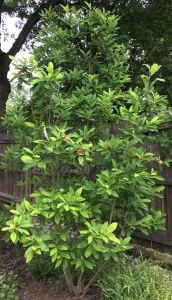Note: The original draft of this post was written on June 22, 2018.

A native of the eastern U.S., the Sweetbay Magnolia (Magnolia virginiana) grows as a small tree or multi-stemmed shrub with an airy feel, more delicate than the better-known Southern Magnolia. It lightens the garden with leaves that open chartreuse in spring, grow longer than wide, and show silver when turned by the wind. The clustered leaves provide a clear view of the plant’s graceful stems, and in a breeze, the leaf clusters seem to float.
Cream-colored, cup-shaped flowers dot the plant from spring into summer and give off a soft, sweet lemon scent. As the flowers fade, the petals turn caramel, curl, and drop. Fruit follows, cones of bright red, glossy seeds that attract flickers and jays.

In fall, the Sweetbay’s leaves display muted shades of yellow, and in Zone 7, a few leaves may remain throughout winter.
When I think of this magnolia, I call it a Sweetbay, because it is one sweet shrub, in scent and shape. But it’s also known as a Swamp Magnolia, a reflection of its native habitat. Unlike other magnolias, it does well in wet soil, such as rain gardens, and in southern swamps it typically grows as a tree, 50 to 60 feet in height.
The first magnolia introduced to European gardens, in 1688, the Sweetbay now faces challenges at home and is listed as an endangered species in Massachusetts and New York and a threatened species in Pennsylvania and Tennessee.
Whether you think of it as a moisture-loving Swamp or a lemony Sweetbay, it’s a magnolia to consider.
If you’d like to read more . . .

“Magnolia virginiana in Flora of North America @ efloras.org.” Flora of North America Editorial Committee, eds. 1993+. Flora of North America North of Mexico. 20+ vols. New York and Oxford. Vol. 3. Accessed June 23, 2018. http://www.efloras.org/florataxon.aspxflora_id=1&taxon_id=220008034.
“Magnolia virginiana | NATIVE PLANT CENTER.” Chesapeake Bay Native Plant Center. Accessed June 17, 2018. http://www.nativeplantcenter.net/plants/magnolia-virginiana/.
“Magnolia virginiana – Plant Finder.” Missouri Botanical Garden. Accessed June 16, 2018. http://www.missouribotanicalgarden.org/PlantFinder/PlantFinderDetails.aspx?taxonid=282522&isprofile=0&letter=M.
“Magnolia virginiana (Sweetbay) | NPIN.” Lady Bird Johnson Wildflower Center – The University of Texas at Austin. Accessed June 16, 2018. https://www.wildflower.org/plants/result.php?id_plant=MAVI2.
“Plants profiles for magnolia virginiana (sweetbay).” USDA, NRCS. 2018. The PLANTS Database (http://plants.usda.gov, 16 June 2018). National Plant Data Team, Greensboro, NC 27401-4901 USA. Accessed June 16, 2018. https://plants.usda.gov/core/profile?symbol=MAVI2.
“Sweetbay Magnolia | Chesapeake Bay Program.” Chesapeake Bay Program. Accessed June 16, 2018. https://www.chesapeakebay.net/S=0/fieldguide/critter/sweetbay_magnolia.
Tropicos.org. Missouri Botanical Garden. Accessed June 23, 2018. http://www.tropicos.org. [Search ‘magnolia virginiana’ in Quick Name Search.]
Edgings Plant Bio #1
